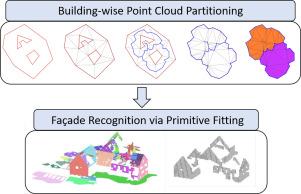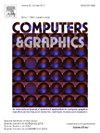PBF-FR: Partitioning beyond footprints for façade recognition in urban point clouds
IF 2.8
4区 计算机科学
Q2 COMPUTER SCIENCE, SOFTWARE ENGINEERING
引用次数: 0
Abstract
The identification and recognition of urban features are essential for creating accurate and comprehensive digital representations of cities. In particular, the automatic characterization of façade elements plays a key role in enabling semantic enrichment and 3D reconstruction. It also supports urban analysis and underpins various applications, including planning, simulation, and visualization. This work presents a pipeline for the automatic recognition of façades within complex urban scenes represented as point clouds. The method employs an enhanced partitioning strategy that extends beyond strict building footprints by incorporating surrounding buffer zones, allowing for a more complete capture of façade geometry, particularly in dense urban contexts. This is combined with a primitive recognition stage based on the Hough transform, enabling the detection of both planar and curved façade structures. The proposed partitioning overcomes the limitations of traditional footprint-based segmentation, which often disregards contextual geometry and leads to misclassifications at building boundaries. Integrated with the primitive recognition step, the resulting pipeline is robust to noise and incomplete data, and supports geometry-aware façade recognition, contributing to scalable analysis of large-scale urban environments.

PBF-FR:在城市点云中进行地形识别的超越足迹分区
识别和识别城市特征对于创建准确和全面的城市数字表示至关重要。特别是,farade元素的自动表征在实现语义丰富和三维重建方面起着关键作用。它还支持城市分析,并支持各种应用程序,包括规划、模拟和可视化。这项工作提出了一个自动识别复杂城市场景中以点云表示的街巷的管道。该方法采用了一种增强的分区策略,通过结合周围的缓冲区,超越了严格的建筑足迹,允许更完整地捕捉立面几何形状,特别是在密集的城市环境中。这与基于霍夫变换的原始识别阶段相结合,可以检测平面和弯曲的farade结构。本文提出的分割方法克服了传统的基于足迹的分割方法的局限性,这种方法经常忽略上下文几何,导致在建筑边界上的错误分类。结合原始识别步骤,生成的管道对噪声和不完整数据具有鲁棒性,并支持几何感知的farade识别,有助于大规模城市环境的可扩展分析。
本文章由计算机程序翻译,如有差异,请以英文原文为准。
求助全文
约1分钟内获得全文
求助全文
来源期刊

Computers & Graphics-Uk
工程技术-计算机:软件工程
CiteScore
5.30
自引率
12.00%
发文量
173
审稿时长
38 days
期刊介绍:
Computers & Graphics is dedicated to disseminate information on research and applications of computer graphics (CG) techniques. The journal encourages articles on:
1. Research and applications of interactive computer graphics. We are particularly interested in novel interaction techniques and applications of CG to problem domains.
2. State-of-the-art papers on late-breaking, cutting-edge research on CG.
3. Information on innovative uses of graphics principles and technologies.
4. Tutorial papers on both teaching CG principles and innovative uses of CG in education.
 求助内容:
求助内容: 应助结果提醒方式:
应助结果提醒方式:


